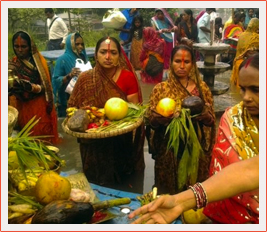Rituals and Traditions of Chhath Puja
The age-old celebration of Chhath Puja is dedicated to Bhagwan Surya (Sun God). It is celebrated to thank Surya for showering blessings and sustaining life & energy on earth.
The rituals and traditions of Chhath Puja are very hard as the Vratti or the devotee fasts for 36 hours without a single bite of the food or a single drop of water. Here the rituals and traditions are discussed in detail.
Rituals & Traditions
Day First: Naha Khay (Bath and Eat) - The very first day of the Dala Chhath is called Naha Khay. On this day, the Vratti takes a bath particularly in the river Ganga & bring the holy water of the river to make Prasad at home.
Day Second: Kharna- A long day fast (without water) is observed by the devotees. They fast for a whole day and end it in the evening after worshipping Chhathi Maiya and easting Prasad. Offering also called Prasad, are made of Rasiao- kheer (cooked rice in milk), puris (deep fired puffs) or chapattis and bananas. The Prasad is distributed among other family members and neighbors.
Day Third: Sandhya Arghya(Evening Offering): On third day Vrattis observe the fast without taking water and food. The whole day is spent in the preparation of the puja offerings. All the offerings (Arghya) are kept in Dauri (a basket made of bamboo sticks), Supali (made of fine bamboo sticks) or in metal basket. The offerings are comprised of Thekua, Puri, Coconut, Banana, Apple, Orange, and other seasonal fruits.
To perform evening rituals, people go to the banks of the river or pond or other clear water bodies. All the Vrattis, family members, friends, and neighbors get together there and offer Sandhya Arghya to the Sun God.
Kosi (Kosiya): Kosi bharna or Kosiya is one of the most glowing and beautiful events during Chhath Pooja. After the Sandhya Arghya or Sanjhiya Ghaat, in angna or the courtyard of the house, kosi is celebrated. Kosi is usually earthen pots or lamps that are kept under the shade of five sugarcane sticks or twenty four sugarcane sticks tied with a yellow cloth. The same ritual of kosi is celebrated on the ghats early in the morning before Bhorwa, Bihani or Morning Arghya.

Day Four: Bihaniya or Bhorwa Ghat (Morning Arghya): This is the last or can say the final day of this auspicious and holy festival. The devotees gather at the bank of the river with their family and friends to offer bhorwa arghya (morning offerings) to the rising Sun. After arghya, devotees knee-down at the ghat to worship Chathi Maiya, distribute thekua and then come back to home.
After their return from the ghat, the devotees or the vrattis take blessings of the elders and break their fast by eating ginger with water.
Then different types of delicious foods are made to serve the vratti.
This is the most important part of the ritual. During the festival, the female folks spend their night by singing traditional Chhath songs like-
- Kelawa jey farela ghawad sey… oh par sooga mandaraaye.....
- Paisee jagawe suruj mal ke amma.....
- Hey uditanaatha…ho gelo bihaan.....
- Roonki jhunki beti maangila padhala pandita damaad hey Chhathi maiya.....
- Bhaiya mora jaayela mahanga moonger.....
- Saama khele chalaali… bhouji sang saheli ho.....
- Kaachi kaachi baans ke bahangiya…bahangi lachkat jaye… Etc.
During Chhath Puja in the month of Kartik, eating any non-vegetarian item by the Vratti and the family member is strictly prohibited. The food is strictly vegetarian and is cooked with utter carefulness without salt, garlic, and onion.
Once in any family, the lady folk starts performing Chhath Puja, the tradition is continued every year by the successive generation. If unable to fast or perform the traditions due to some reasons, it is suggested that the arghya should be given by some other vratti. The vratti who cannot give arghya is said to fast. Helping a vratti during Chhath Puja is said to be the most auspicious thing or the best act of life as Chatthi Maiya showers her blessings on everyone.
There is also a tradition of “Dandwat Pranam” or “Dand Khinchna” during Chhath Puja. Both men and women who have wished or wish to succeed in something, take an oath to go to the Chhath Ghat by lying and saluting on the ground in simple cloth. They start “Dandwat Pranaam” the moment after Chhath Daura starts arriving on the Ghat. With the help of a “Kanda” a type of stick easily found in locality or in fields, the devotee draws a round line by lying on the ground with the help of stomach and stretching both hands in “Pranaam Mudra”. After arriving on the Ghat after “Dand” the devotee takes a bath in the holy river and worships Chhathi Maiya.






